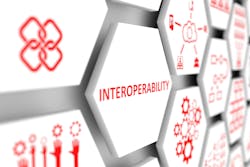U.S. healthcare organizations are participating in the national interoperability networks of Carequality and CommonWell Health Alliance to share patient records, but the number of organizations connected to these plug-and-play networks and the usability of the shared data vary significantly depending on the electronic health record (EHR) in use, according to a new report from the Utah-based KLAS Research.
This report—a follow-up to research published in early 2019—examines adoption and usability among advanced users of the main acute and ambulatory care EHR vendors. Cerner, Epic and NextGen are best at making patient data from outside the clinician's health system usable for clinicians.
According to the report’s specifics, NextGen Healthcare is the only ambulatory-specific EHR vendor to provide a strong usability experience for all interoperability workflows measured by KLAS. Over the last 18 months, NextGen has made significant progress in enabling data reconciliation and the ingestion of progress notes and lab data, KLAS concluded. Indeed, in last year’s report, KLAS found that “companies such as athenahealth, eClinicalWorks, NextGen Healthcare, and Virence Health (GE Healthcare) are all still working to make notes and labs easier to consumers.”
The interoperability workflows measured in this report include: automatic querying; automatic patient matching; flow of outside data; reconciliation of problems, allergies, medications, and immunizations (PAMI data, lab data workflow; and progress notes workflow. The vendors with the best overall usability of shared data scores were NextGen and Epic, each receiving a 4.25 out of 5, followed by Cerner, which scored a 3.75. KLAS researchers note that this report focuses on the usability of shared patient data brought in via connections with Carequality and CommonWell. Data on other means of interoperability, such as custom interfaces and HIEs, was excluded.
Epic and Cerner are also leaders in enabling access to outside data. Epic has continued to enhance the end-user experience; their Happy Together solution provides the most natural integration of outside data into the clinician workflow, including the recent addition of basic lab trending, according to KLAS. Cerner, meanwhile, delivers strong capabilities for accessing and incorporating a wide variety of outside data into the patient record. Customers say Cerner is currently building functionality to automatically ingest progress notes and lab data. Customers of both Cerner and Epic say the next step is for the vendors to reduce the duplication of problems, allergies, medications, and immunizations (PAMI).
As more organizations have connected to the national framework, duplicate medication data has become more prevalent, and provider organizations are becoming increasingly frustrated by the amount of manual effort required to reconcile it. NextGen Healthcare is the only vendor whose customers report significant improvement in this area, KLAS reported. Specifically, the NextGen EHR is able to filter out duplicate medications, even for inexact matches (e.g., Tylenol vs. acetaminophen). While other solutions may be capable of flagging duplicate information and removing some of it, customers say the process is often still very manual.
CommonWell, an alliance formed six years ago, operates a health data sharing network that enables interoperability using a suite of services aiming to simplify cross-vendor nationwide data exchange. Carequality, an initiative of The Sequoia Project that launched about a year later, is a national-level, consensus-built, common interoperability framework to enable exchange between and among health data sharing networks. Nearly all major EHR vendors have aligned with one or both of these options, according to KLAS.
Late in 2018, CommonWell Carequality announced “general availability,” enabling CommonWell subscribers to engage in health data exchange through directed queries with Carequality-enabled providers, and vice versa.
Cerner has been encouraging customers to adopt the CommonWell connection for some time, and over the past 18 months, the number of customers live has doubled, meaning a majority of clients are now connected. Cerner has removed barriers to adoption by standardizing data-sharing governance (so customers don’t have to shoulder this) and including the connection as an automatic part of recent upgrades (customers must opt out, rather than opt in), KLAS detailed.
What’s more, through the CommonWell- Carequality connection, Cerner customers can share with Epic exchange partners, opening up access to a large volume of data. NextGen Healthcare has also continued to advocate for the adoption of Carequality among their customer base. Like Cerner, they have removed adoption barriers by including the connection in upgrades. Customers report value from increased data sharing with critical exchange partners and have good satisfaction with the data’s usability. eClinicalWorks customers have been actively connecting; their usability experience remains similar to what it was in the past. athenahealth and Epic continue to lead in overall adoption, with nearly all customers connected, according to the KLAS.
In an accompanying report, KLAS noted that since it was established in November 2018, the CommonWell-Carequality connection has been utilized mostly by acute and ambulatory care organizations. But more recently, post–acute care (home health, hospice, long-term care) and behavioral health organizations have started to connect to the national networks; the large majority of these early adopters find the connection valuable, KLAS found. As such, the research organization produced its first report on interoperability in the post–acute care and behavioral health markets, and examines which vendors are connected today and the level of usability achieved by their most advanced customers.
The report concluded that Netsmart, which is the largest vendor in behavioral health and has a widespread post–acute care presence, provides Carequality connections for their myUnity home health/long-term care platform and their myAvatar behavioral health platform; approximately 25 percent to 35 percent of these customer bases have connected.
In post–acute care, MatrixCare Homecare (Brightree) was one of the first solutions connected; approximately 100 customers have adopted the no-cost CommonWell connection, which requires little effort to establish, KLAS reported. More recently, MatrixCare has connected their long-term care solution to Carequality; about 30 customers are live.
Other notable vendors in the post-acute care report include Homecare Homebase, the most prevalent vendor among large home health agencies, which announced their connection to Carequality in June 2019; KLAS estimates that about 10 percent of customers are currently live. Meanwhile, PointClickCare recently enabled a Carequality connection, and a small portion of customers have implemented. WellSky, one of the largest post–acute care vendors, plans to generally release their connection to CommonWell across various platforms starting in Q1 2021.
For most of these vendors, connections are early, and even the adoption leaders lag in comparison to the acute and ambulatory care leaders such as athenahealth, Epic, and Cerner, KLAS concluded.


